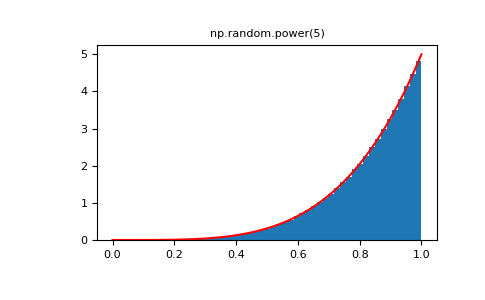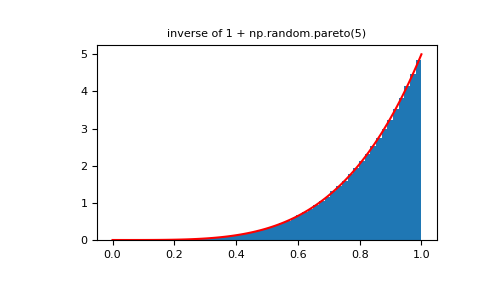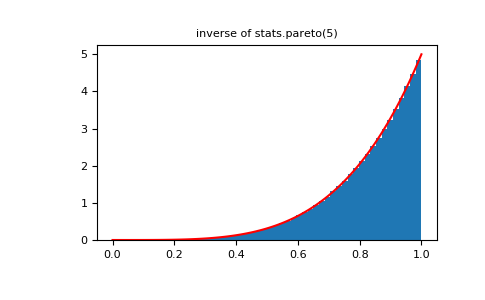numpy.random.power¶
-
numpy.random.power(a, size=None)¶ 从具有正指数a-1的功率分布中在[0,1]中绘制样本。
也称为功函数分布。
参数: a:float
参数,> 0
size:int或tuple的整数,可选
输出形状。如果给定形状是例如
(m, n, k),则m * n * k默认值为None,在这种情况下返回单个值。返回: samples:ndarray或scalar
返回的样本位于[0,1]。
上升: ValueError
如果一个
笔记
概率密度函数是
幂函数分布只是帕累托分布的逆。它也可以被看作是Beta分布的一种特殊情况。
例如,它用于对保险索赔的超额报告建模。
参考文献
[R257] Christian Kleiber,Samuel Kotz,“经济学和精算科学中的统计大小分布”,Wiley,2003。 [R258] Heckert,N.A。和Filliben,James J.“NIST Handbook 148:Dataplot Reference Manual,Volume 2:Let subcommands and Library Functions”,National Institute of Standards and Technology Handbook Series,2003年6月。http://www.itl.nist.gov/div898/software/ dataplot / refman2 / auxillar / powpdf.pdf 例子
从分布绘制样本:
>>> a = 5. # shape >>> samples = 1000 >>> s = np.random.power(a, samples)
显示样本的直方图,以及概率密度函数:
>>> import matplotlib.pyplot as plt >>> count, bins, ignored = plt.hist(s, bins=30) >>> x = np.linspace(0, 1, 100) >>> y = a*x**(a-1.) >>> normed_y = samples*np.diff(bins)[0]*y >>> plt.plot(x, normed_y) >>> plt.show()

将功率函数分布与帕累托逆矩阵进行比较。
>>> from scipy import stats >>> rvs = np.random.power(5, 1000000) >>> rvsp = np.random.pareto(5, 1000000) >>> xx = np.linspace(0,1,100) >>> powpdf = stats.powerlaw.pdf(xx,5)
>>> plt.figure() >>> plt.hist(rvs, bins=50, normed=True) >>> plt.plot(xx,powpdf,'r-') >>> plt.title('np.random.power(5)')
>>> plt.figure() >>> plt.hist(1./(1.+rvsp), bins=50, normed=True) >>> plt.plot(xx,powpdf,'r-') >>> plt.title('inverse of 1 + np.random.pareto(5)')
>>> plt.figure() >>> plt.hist(1./(1.+rvsp), bins=50, normed=True) >>> plt.plot(xx,powpdf,'r-') >>> plt.title('inverse of stats.pareto(5)')


